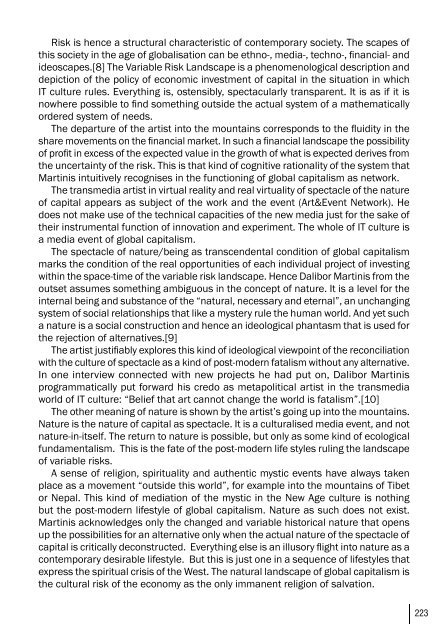art-e-conomy _ reader - marko stamenkovic
art-e-conomy _ reader - marko stamenkovic
art-e-conomy _ reader - marko stamenkovic
You also want an ePaper? Increase the reach of your titles
YUMPU automatically turns print PDFs into web optimized ePapers that Google loves.
Risk is hence a structural characteristic of contemporary society. The scapes of<br />
this society in the age of globalisation can be ethno-, media-, techno-, financial- and<br />
ideoscapes.[8] The Variable Risk Landscape is a phenomenological description and<br />
depiction of the policy of economic investment of capital in the situation in which<br />
IT culture rules. Everything is, ostensibly, spectacularly transparent. It is as if it is<br />
nowhere possible to find something outside the actual system of a mathematically<br />
ordered system of needs.<br />
The dep<strong>art</strong>ure of the <strong>art</strong>ist into the mountains corresponds to the fluidity in the<br />
share movements on the financial market. In such a financial landscape the possibility<br />
of profit in excess of the expected value in the growth of what is expected derives from<br />
the uncertainty of the risk. This is that kind of cognitive rationality of the system that<br />
M<strong>art</strong>inis intuitively recognises in the functioning of global capitalism as network.<br />
The transmedia <strong>art</strong>ist in virtual reality and real virtuality of spectacle of the nature<br />
of capital appears as subject of the work and the event (Art&Event Network). He<br />
does not make use of the technical capacities of the new media just for the sake of<br />
their instrumental function of innovation and experiment. The whole of IT culture is<br />
a media event of global capitalism.<br />
The spectacle of nature/being as transcendental condition of global capitalism<br />
marks the condition of the real opportunities of each individual project of investing<br />
within the space-time of the variable risk landscape. Hence Dalibor M<strong>art</strong>inis from the<br />
outset assumes something ambiguous in the concept of nature. It is a level for the<br />
internal being and substance of the “natural, necessary and eternal”, an unchanging<br />
system of social relationships that like a mystery rule the human world. And yet such<br />
a nature is a social construction and hence an ideological phantasm that is used for<br />
the rejection of alternatives.[9]<br />
The <strong>art</strong>ist justifiably explores this kind of ideological viewpoint of the reconciliation<br />
with the culture of spectacle as a kind of post-modern fatalism without any alternative.<br />
In one interview connected with new projects he had put on, Dalibor M<strong>art</strong>inis<br />
programmatically put forward his credo as metapolitical <strong>art</strong>ist in the transmedia<br />
world of IT culture: “Belief that <strong>art</strong> cannot change the world is fatalism”.[10]<br />
The other meaning of nature is shown by the <strong>art</strong>ist’s going up into the mountains.<br />
Nature is the nature of capital as spectacle. It is a culturalised media event, and not<br />
nature-in-itself. The return to nature is possible, but only as some kind of ecological<br />
fundamentalism. This is the fate of the post-modern life styles ruling the landscape<br />
of variable risks.<br />
A sense of religion, spirituality and authentic mystic events have always taken<br />
place as a movement “outside this world”, for example into the mountains of Tibet<br />
or Nepal. This kind of mediation of the mystic in the New Age culture is nothing<br />
but the post-modern lifestyle of global capitalism. Nature as such does not exist.<br />
M<strong>art</strong>inis acknowledges only the changed and variable historical nature that opens<br />
up the possibilities for an alternative only when the actual nature of the spectacle of<br />
capital is critically deconstructed. Everything else is an illusory flight into nature as a<br />
contemporary desirable lifestyle. But this is just one in a sequence of lifestyles that<br />
express the spiritual crisis of the West. The natural landscape of global capitalism is<br />
the cultural risk of the e<strong>conomy</strong> as the only immanent religion of salvation.<br />
223


